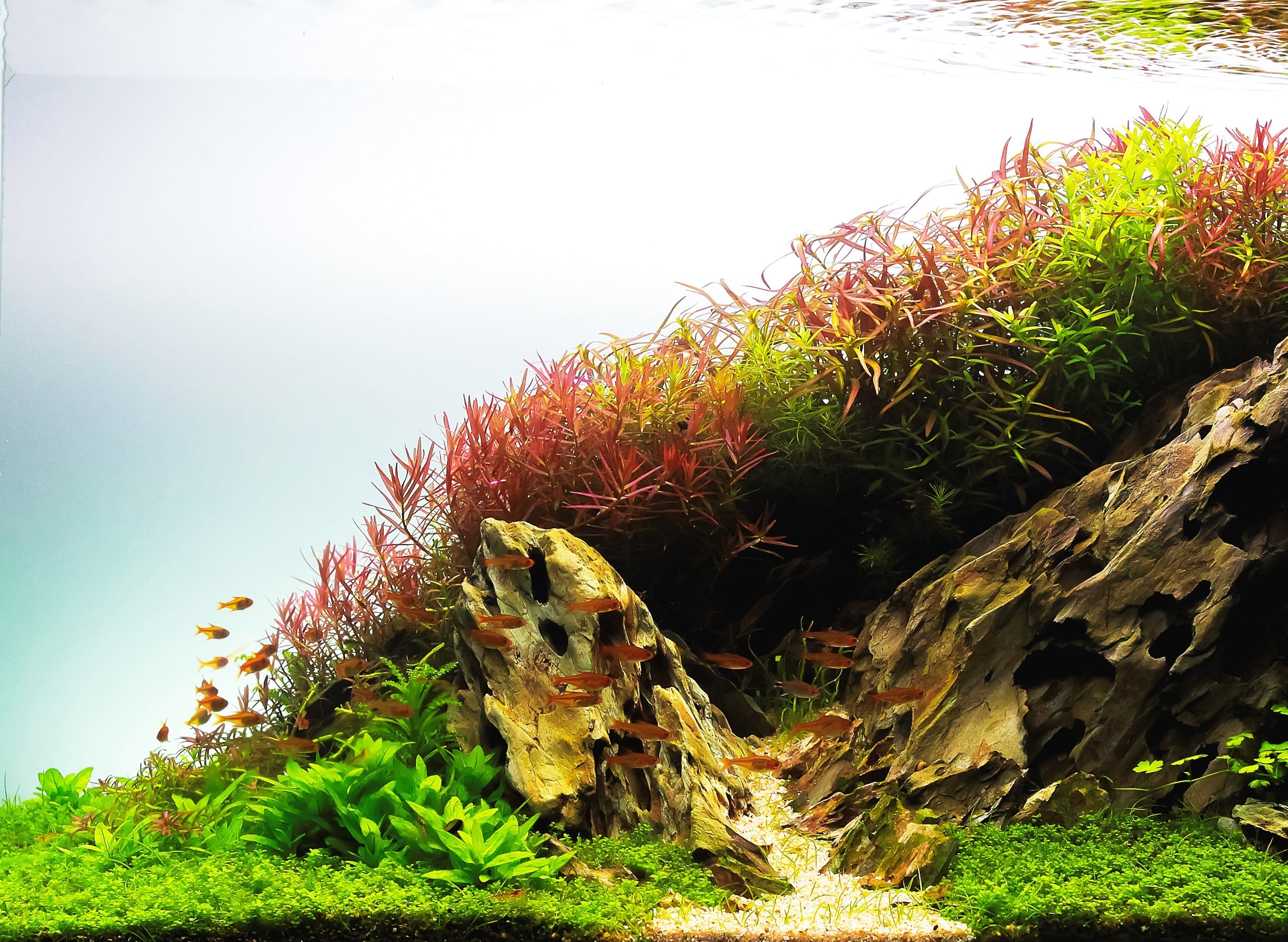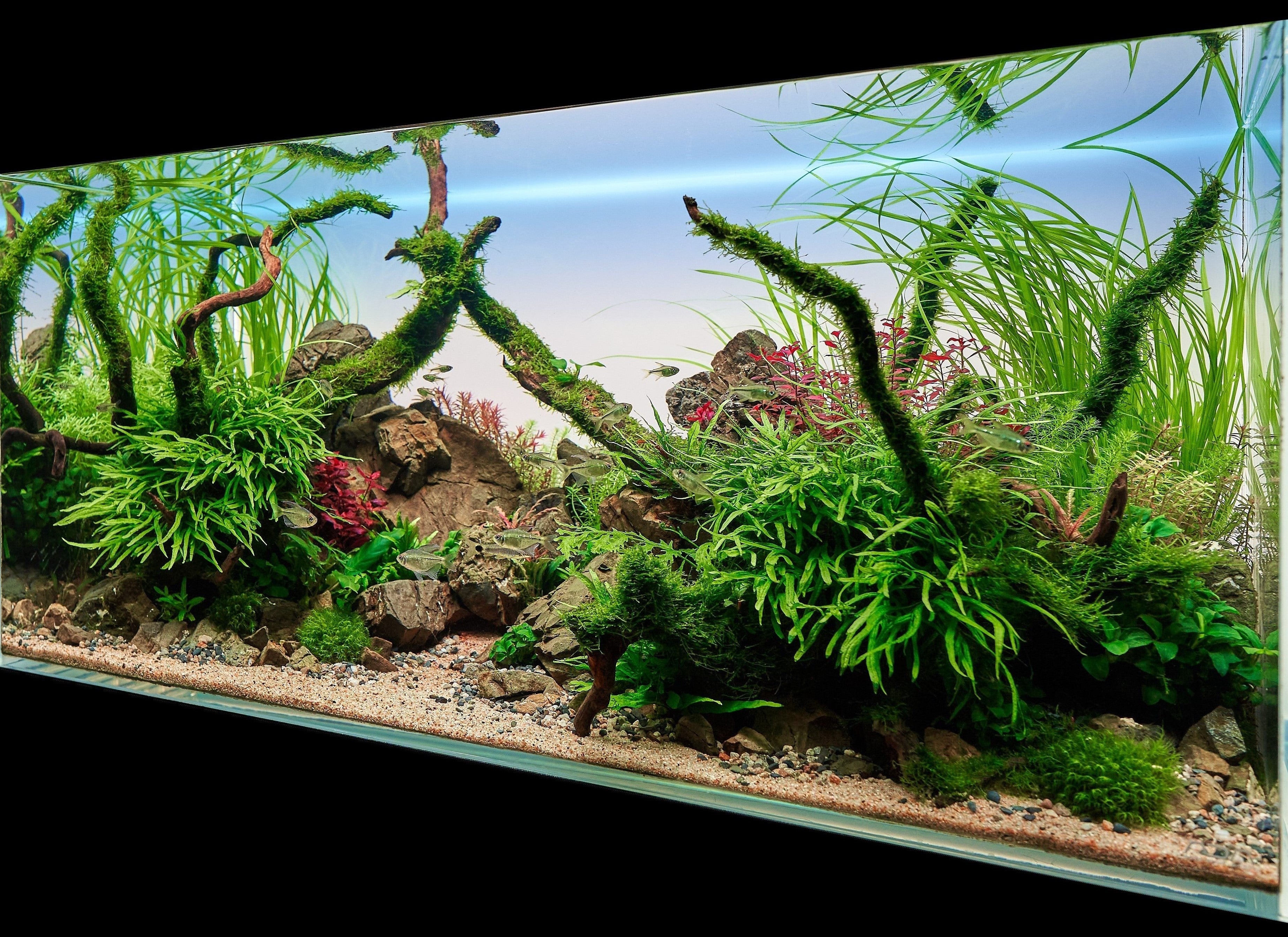Small aquariums are very popular, but small nano aquariums can be hard to stock with fish due to the limited water volume so sometimes a shrimp dedicated tank is your best option. Cherry shrimp are fun to watch, easy to breed and you can even make some money selling the shrimp you breed. In this article I will focus on cherry shrimp or ‘neocaridina davidi’ but there are many other shrimps you can choose to keep, some of which may need specific water parameters like crystal red shrimp for example. Cherry shrimp are by far on of the easiest shrimp to care for and their bright colours make them an excellent choice for beginner shrimp keepers. Cherry shrimp come in a variety of colours such as red, yellow and blue. Serious shrimp breeders even grade their shrimp depending on the intensity of their colour, be prepared to pay more for higher graded specimens. In my opinion spending a bit more on a high quality cherry shrimp at the start will give you the best results when breeding. Cherry shrimp do well in a range of water parameters, ensure you have a moderately hard tap water as they will regularly molt, always use tap water conditioner which removes heavy metals, chlorine and chloramine. Aim for a pH range of around 7-8. The most importantly ensure your setup is cycled before you add any shrimp. You will always need zero ammonia and nitrite as cherry shrimp are extremely sensitive to bad water parameters. Aim to keep nitrate below 20 ppm for cherry shrimp. They do best in a stable environment so do frequent smaller water changes rather than large ones as the sudden shift in parameters like pH, GH and KH can shock them. Most shrimp keepers recommend drip acclimating shrimp to their new setup for a few hours, this gives them time to slowly adjust to their new water parameters. If your aim is to breed cherry shrimp it is best practice to keep one colour as unfortunately the colours do not mix when they breed, you may find more of the shrimplets revert to their wild brown colouration. Once the setup is established, keep the environment stable, feed your shrimp and after a few months you will notice baby shrimp or ‘shrimplets’.
Tank Size – I have personally breed cherry shrimp in tanks as small as 2 gallons! Provided they have enough space to move, swim in the open and hide you should be okay. Generally, it’s a good idea to start with at least six shrimp to give yourself a good chance of getting both males and females. For beginner I would recommend a 5 or 10 gallon as a good tank size to start with.
Tank Setup – When setting up the interior of your new shrimp tank, think natural. Cherry shrimp do best in a planted tank, I have never seen them do well in a tank without plants. Plants provide them with a grazing surface and a biofilm to feed on. Plants also reduce nitrate which helps the water quality for your cherry shrimp. I always suggest moss in a shrimp tank, moss looks great and provides hiding spaces for young shrimp, crucial if you plan to keep fish with your cherry shrimp. Rock and wood are also a good idea, algae will form on these surfaces providing a great grazing ground for your cherry shrimp. You have a few substrate options; sand is a good option if your tap water has optimum parameters. If you tap water parameters could be better then consider getting an aquarium soil, many of these are tailored towards creating stable pH, GH and KH parameters.
Equipment – Shrimp have almost no bioload, for the most part it is negligible however they will need a cycled tank. Avoid internal filters or external filters, especially if you do not have a sponge covering the inlet as small shrimplets can be sucked into the filter. A sponge filter is your best option, an air driven sponge filter provides a gentle flow and harbours plenty of beneficial bacteria to break down ammonia and nitrite. Sponge filters regularly become a popular grazing ground for you shrimp as debris lands there. Because there is a dense sponge on surrounding this type of filter it means you will not suck up any shrimplets. No filter planted shrimp tanks are a possibility for experienced shrimp keepers and aquascapers, although it is very important to establish plant growth before adding shrimp as healthy plant growth will help maintain your water quality. No filter shrimp tanks work for a minimally stocked setup but if your aim is to breed cherry shrimp or if you are a beginner a sponge filter is the best option. For most people a cherry shrimp tank does not need any form of heater, they will do well at room temperature, provided it stays around 72F. I have seen cherry shrimp do well and breed in tropical setups with nano fish at higher temperatures too but if you are setting up a shrimp only tank, room temperature will be fine. Because you will need plants in your shrimp tank some form of lighting on a timer is required to keep the plants in good health.
Feeding – This element of cherry shrimp keeping is often overlooked in a large planted tank with fish and shrimp, generally cherry shrimp can thrive off of leftover food, dead leaves and algae. Although in a shrimp only tank you must take steps to make sure you provide your shrimp with enough food. Shrimp specific foods are best, rather than relying on just fish food. Shrimp pellets will provide a variety of nutrients to help shrimp grow and molt. Feed once a day or once every other for best results when breeding cheery shrimp. Give them as much food as they can eat within around two hours.
Breeding – Shrimp are easy to breed. Setup their tank, keep the environment stable, feed them and they will breed! Remember your shrimp may still be juvenile when you purchase them so they will need time to grow before they can breed. Be patient if you have just added your shrimp, it can take them a few months to settle in, females will carry their eggs for about a month before they hatch. Keep and eye out for small green or yellow egg on the under belly of the female cherry shrimp. Female cherry shrimp are generally larger and more vibrant that males, females also have a more rounded body than males and can develop a saddle on their back. Over time you can end up with an explosion of shrimp, I have seen shrimp tanks packed with breeding cherry shrimp! Eventually they will reach a maximum population in any given tank, also remember food is a limiting factor of population growth for cherry shrimp. Some shrimp keepers/breeders take things a little more seriously than others. Some shrimp keepers just let their shrimp population do their thing, but some prefer to selectively breed a specific morph and perhaps sell their high grade juvenile shrimp for a profit. It doesn’t matter what end of the spectrum you are, just ensure you take good care of your shrimp and have fun! Certain colour morphs are less stable than other and you may find a percentage of shrimplets have reverted to their wild colour or perhaps some are just not as colourful as you had hoped. These shrimps are still healthy they just may not exhibit the colour or pattern that you desire, no problem it may be time to cull your shrimp population. While the word ‘cull’ may have a negative connotation in the mammal world, in the shrimp world it just means to remove or separate the shrimp which are less colourful. There is nothing wrong with these less colouful shrimp, they can be sold at a slightly reduced price which can be great for shrimp keepers which are not overly bothered about colour. I always recommend buy your cherry shrimp from a local breeder, that way you can be sure they are already well adapted to your local tap water.
Tankmates – If your aim is to breed shrimp then keeping them on their own is the best option. Unfortunately, even some of the fish recommended as cherry shrimp tanks mates can occasionally snack on a shrimplet if they get the chance. Bristlenose are a great option, they are peaceful and due to the way they feed they are very unlikely to eat any shrimplets. Most nano fish do well with cherry shrimp, just beware any fish which can fit a cherry in its mouth may try to eat them if they get the chance. Provide dense plants and moss throughout the aquascape giving the shrimp a chance to retreat if needed.
What to look out for – There are a few things to look out for when keeping cherry shrimp. Keep an eye out dragonfly nymphs in your shrimp tank as they will eat cherry shrimp if they get the chance. If this is your first shrimp only tank you may find small detritus worms or copepods in your shrimp tank which are harmless, the only reason you see them in shrimp tanks and not fish tanks is because fish quickly eat them when given the chance. Keep an eye out for failed molts, this is an indication that your water parameters are incorrect and need to be remedied. There are a variety of bacteria and parasite issues that can affect cherry shrimp, keep an eye out for odd growths or colour changes which could indicate a problem and act fast. Most cases it is best to separate infected shrimp and treat them in a hospital tank. Although, in truth I have kept shrimp for years and never had any problems. Lastly, keep an eye out for odd behaviour such as overactivity or inactivity, this could be a sign of poor water quality.
Pro Tip – Choose a location which allow you to get up close to the tank, a desk is the best location for a shrimp tank in my opinion. This allows you to easily view your shrimp as remember they are small and their shrimplets are tiny! After all aquarium are meant to be enjoyed!
AQUAnatur
AQUAnatur was created by an established UK aquarium installation and maintenance company near London which has been running for over 25 years! Our team are very experienced and happy to help offer advice with any aquarium questions. We are always available via phone or email Monday -Friday, feel free to contact us, we would love to help! AQUAnatur supply a range of aquariums and aquascaping products. If you have a question, please leave a comment or contact us via phone or email.
By Alasdair McPhail




Leave a comment
All comments are moderated before being published.
This site is protected by hCaptcha and the hCaptcha Privacy Policy and Terms of Service apply.